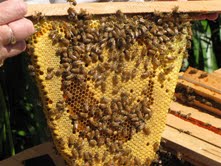Baby Bees
 The bee hive is constantly busy – actually, that is the mother of all understatements. The queen lays up to 2000, yes, that is two thousand, eggs a day during the spring and summer, constantly replenishing the hive with new bees that hatch out after 3 weeks of egg, larvae, pupa then adult.
The bee hive is constantly busy – actually, that is the mother of all understatements. The queen lays up to 2000, yes, that is two thousand, eggs a day during the spring and summer, constantly replenishing the hive with new bees that hatch out after 3 weeks of egg, larvae, pupa then adult.
The drones life cycle is slightly shorter, around 16 days, the queen herself, about 24 days. Above is a photo I took when checking my TopBar hive, of beautifully made wax comb full of brood, which is what we call the cells that have been laid in, the larvae fed by the worker bees with royal jelly and pollen, then when ready to pupate, are covered with a cap of wax, left to do their thing and develop into an adult bee, ready to work as soon as she chews her way
out of the cell. Capped brood is a different colour to capped nectar (honey), a more yellow/brown and slightly higher, drone cells are higher still and the cell a queen develops in is shaped sort of like a peanut case. Note the bright red propolis on the bars, I would love to know from which plant they are collecting it from.
I am really pleased with how the queen is laying, not many cells missed, with room around the edges for pollen and nectar to be stored, ready to use as food for the next batch of baby bees !
loading...
loading...
Tags: Environment, honey bee



Voices of our community